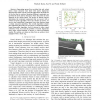Free Online Productivity Tools
i2Speak
i2Symbol
i2OCR
iTex2Img
iWeb2Print
iWeb2Shot
i2Type
iPdf2Split
iPdf2Merge
i2Bopomofo
i2Arabic
i2Style
i2Image
i2PDF
iLatex2Rtf
Sci2ools
ICRA
2009
IEEE
2009
IEEE
Flow separation for fast and robust stereo odometry
— Separating sparse flow provides fast and robust stereo visual odometry that deals with nearly degenerate situations that often arise in practical applications. We make use of the fact that in outdoor situations different constraints are provided by close and far structure, where the notion of close depends on the vehicle speed. The motion of distant features determines the rotational component that we recover with a robust two-point algorithm. Once the rotation is known, we recover the translational component from close features using a robust one-point algorithm. The overall algorithm is faster than estimating the motion in one step by a standard RANSACbased three-point algorithm. And in contrast to other visual odometry work, we avoid the problem of nearly degenerate data, under which RANSAC is known to return inconsistent results. We confirm our claims on data from an outdoor robot equipped with a stereo rig.
| Added | 23 May 2010 |
| Updated | 23 May 2010 |
| Type | Conference |
| Year | 2009 |
| Where | ICRA |
| Authors | Michael Kaess, Kai Ni, Frank Dellaert |
Comments (0)

